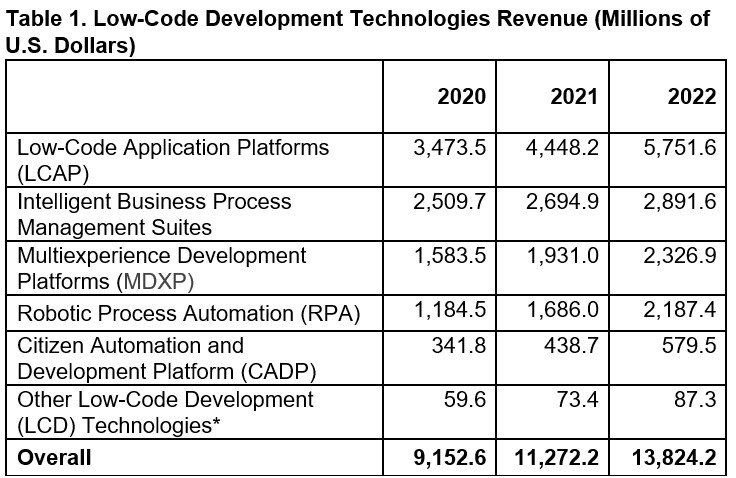Surge in Remote Development Boosted Low-Code Adoption Despite Ongoing Cost Optimization Efforts
The worldwide low-code development technologies market is projected to total $11.3 billion in 2021, an increase of 23.2% from 2020, according to the latest forecast by Gartner, Inc. The surge in remote development during the COVID-19 pandemic will continue to boost low- code adoption, despite ongoing cost optimization efforts.
“While low-code application development is not new, a confluence of digital disruptions, hyperautomation and the rise of composable business has led to an influx of tools and rising demand,” said Fabrizio Biscotti, research vice president at Gartner.
Low-code as a general social and technological movement is expected to continue growing significantly. For example, low-code application platforms (LCAP) are expected to remain the largest component of the low-code development technology market through 2022, increasing 65% from 2020 to reach $5.8 billion (see Table 1).
*Other LCD technologies include rapid mobile app development (RMAD) tools and rapid application development (RAD) tools. Low-code is the evolution of RAD to cloud and SaaS models. Note that Gartner defines a no-code application platform as an LCAP that only requires text entry for formulae or simple expressions. The LCAP market, therefore, includes no-code platforms. Furthermore, “no code” is not a sufficient criterion for tasks like citizen development, as many complex tooling configuration tasks are no code but still require specialist skills. Columns may not add to totals shown because of rounding. Source: Gartner (February 2021)
Digital Business Acceleration Drives Application DeliveryDigital business acceleration is putting pressure on IT leaders to dramatically increase application delivery speed and Time to Value. The increased demand for custom software solutions in support of digital transformation has sparked the emergence of citizen developers outside of IT, which, in turn has influenced the rise in low-code.
Gartner research says, on average, 41% of employees outside of IT – or business technologists – customize or build data or technology solutions. Gartner predicts that half of all new low-code clients will come from business buyers that are outside the IT organization by year-end 2025, too.
“The economic consequences of the COVID-19 pandemic have validated the low-code value proposition,” said Mr. Biscotti. “Low-code capabilities that support remote work function, such as digital forms and workflow automation, will be offered with more elastic pricing since they will be required to keep the lights running.”
SaaS and Hyperautomation Will Drive Low-Code AdoptionAll of the major software-as-a-service (SaaS) vendors currently provide capabilities that incorporate low-code development technologies. As SaaS grows in popularity, and these vendors’ platforms are increasingly adopted, the low-code market will see commensurate growth in LCAPs and process automation tooling.
Additionally, business technologists want to create and execute their own ideas to drive more automation across their business applications and workflows. The needs of business-driven hyperautomation will be one of the top three drivers for low-code adoption through 2022.
“Globally, most large organizations will have adopted multiple low-code tools in some form by year-end 2021. In the longer term, as companies embrace the tenets of a composable enterprise, they will turn to low-code technologies that support application innovation and integration,” said Mr. Biscotti.
Gartner clients can read more in “Forecast Analysis: Low-Code Development Technologies.”
Gartner Application Innovation & Business Solutions SummitApplication innovation and software engineering strategies will be further discussed at the Gartner Application Innovation & Business Solutions Summits 2021 taking place virtually May 26-27 in the Americas, June 16-17 in EMEA and June 21-22 in Japan. Follow news and updates from the conferences on Twitter using #GartnerAPPS.
About GartnerGartner, Inc. (NYSE: IT) is the world’s leading research and advisory company and a member of the S&P 500. We equip business leaders with indispensable insights, advice and tools to achieve their mission-critical priorities and build the successful organizations of tomorrow.
Our unmatched combination of expert-led, practitioner-sourced and data-driven research steers clients toward the right decisions on the issues that matter most. We are a trusted advisor and an objective resource for more than 14,000 organizations in more than 100 countries — across all major functions, in every industry and organization size.
To learn more about how we help decision makers fuel the future of business, visit gartner.com.
Source: PC and Associates Consulting
